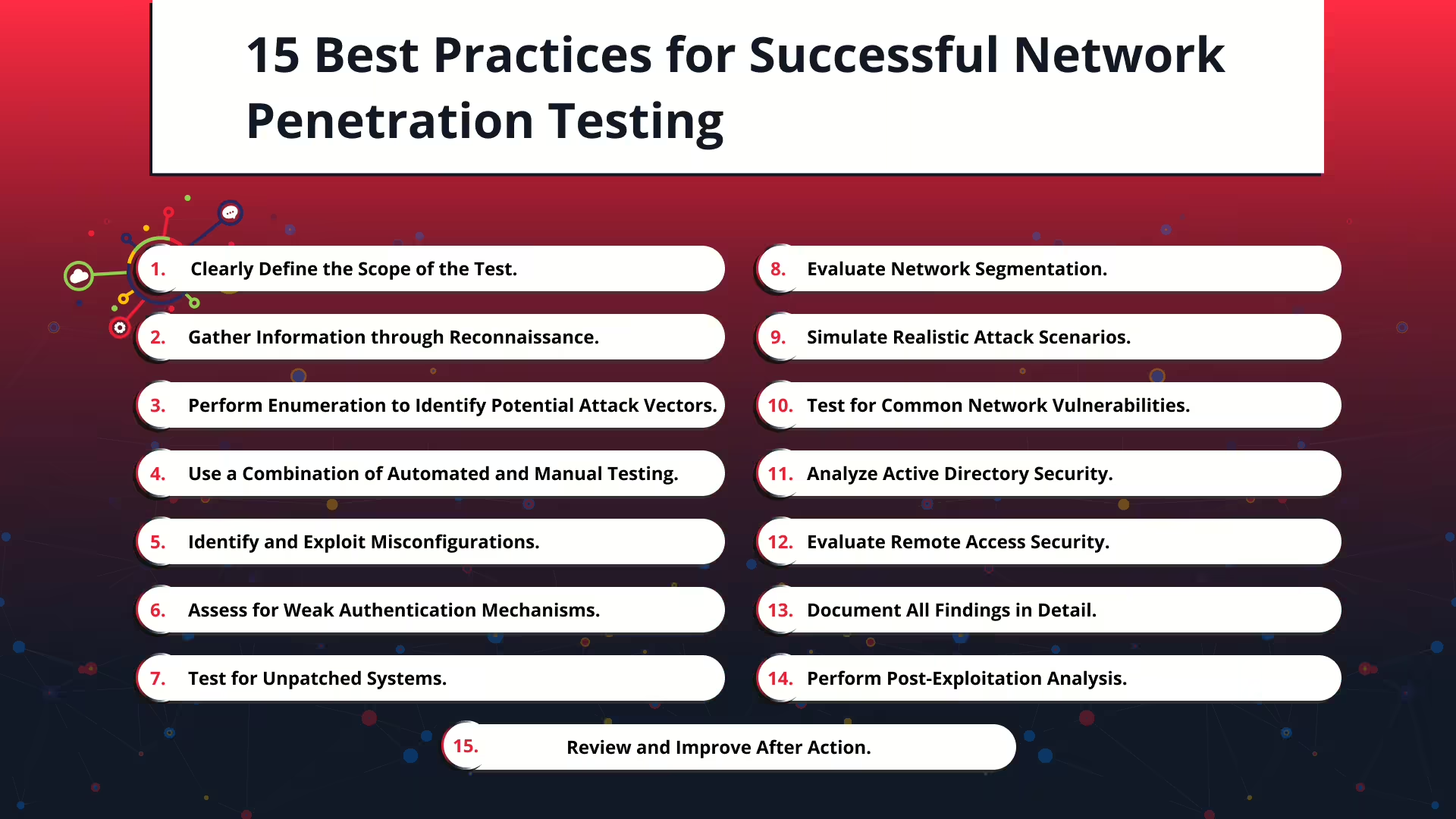
Nov 5, 2024 Information hub
15 Best Practices for Successful Network Penetration Testing
Network penetration testing is a crucial process for identifying and addressing vulnerabilities within your network infrastructure. By simulating real-world attacks, organizations can strengthen their security defenses. Here are 15 best practices for conducting network pentesting that ensure a thorough and effective assessment.
1. Clearly Define the Scope of the Test
Before starting any network pentesting, clearly define what areas of the network will be tested. This ensures that the testing is focused, avoids unintended disruptions, and ensures compliance with internal policies.
Tip: Make sure to include critical assets, like servers and databases, to get a complete view of potential vulnerabilities.
2. Gather Information through Reconnaissance
Passive and active reconnaissance helps collect essential data about the network. This includes identifying open ports, services running on the network, and publicly accessible assets.
Tip: Use tools like Nmap or OpenVAS for active scanning and gather OSINT for passive reconnaissance to get a detailed network map.
3. Perform Enumeration to Identify Potential Attack Vectors
Enumeration focuses on uncovering specific details such as usernames, shares, and services that could be exploited. This step provides insight into the possible attack vectors an attacker might use.
Tip: Always cross-reference your enumeration results with known vulnerabilities to prioritize risks efficiently.
4. Use a Combination of Automated and Manual Testing
Automated tools can speed up vulnerability detection, but manual testing allows for more in-depth analysis. By combining both, you get comprehensive coverage of the network.
Tip: While automation is great, manual testing helps identify complex vulnerabilities that automated tools may miss.
5. Identify and Exploit Misconfigurations
Misconfigurations, such as open ports or insecure services, are common targets for attackers. Check for improper firewall rules, weak access control lists (ACLs), and other settings that expose the network.
Tip: Regularly audit network configurations to catch vulnerabilities early, rather than waiting for a penetration test.
6. Assess for Weak Authentication Mechanisms
Weak or default credentials remain a primary cause of breaches. Ensure that robust password policies are in place, and two-factor authentication (2FA) is enabled where applicable.
Tip: Use password spraying techniques during testing to check for weak passwords without triggering account lockouts.
7. Test for Unpatched Systems
Ensure that all software and firmware are up to date. Unpatched systems present one of the most common entry points for attackers.
Tip: Maintain an updated patch management system and test for outdated software during the pentest.
8. Evaluate Network Segmentation
Proper network segmentation limits the spread of an attack. Test if lateral movement within the network is possible and whether sensitive data is isolated.
Tip: Use VLAN hopping techniques to check for segmentation flaws and verify if traffic is properly isolated.
9. Simulate Realistic Attack Scenarios
Perform attacks based on realistic threat models. Consider potential external threats, as well as insider threats, to gain a complete view of how vulnerable your network might be.
Tip: Work closely with the IT team to develop scenarios that reflect your organization’s specific threat landscape.
10. Test for Common Network Vulnerabilities
Known vulnerabilities like SMB protocol weaknesses, open FTP, and unsecured SNMP should be assessed. These vulnerabilities often provide easy entry points for attackers.
Tip: Leverage vulnerability databases like CVE and CWE to stay updated on the latest network vulnerabilities.
11. Analyze Active Directory Security
Active Directory (AD) is a critical part of many enterprise networks. Ensure that AD is configured correctly to prevent unauthorized access and privilege escalation.
Tip: Perform AD enumeration and check for weak Kerberos ticket policies, as well as poorly defined user permissions.
12. Evaluate Remote Access Security
Remote access solutions like VPNs and remote desktops must be secured. Ensure that remote access tools have strong encryption and authentication protocols.
Tip: Test VPN tunnels for leaks and check if remote access can be bypassed through social engineering techniques.
13. Document All Findings in Detail
Detailed documentation is vital for understanding vulnerabilities and creating remediation plans. Include all vulnerabilities, their risk levels, and the suggested mitigation steps.
Tip: Always prioritize vulnerabilities based on their impact and provide detailed steps for remediation to facilitate quick fixes.
14. Perform Post-Exploitation Analysis
After successfully gaining access, check the extent of the damage an attacker could inflict. Look for ways to escalate privileges or pivot to other systems.
Tip: Post-exploitation is the key to understanding the overall impact of an attack. Simulate lateral movements to identify potential damage paths.
15. Review and Improve After Action
Once the testing is complete, conduct a thorough review of the results. Implement the suggested mitigations and use the findings to enhance your security posture for the future.
Tip: Schedule regular follow-up penetration tests to verify that fixes were applied and to detect any new vulnerabilities.
Conclusion
By following these best practices, you can ensure that your network penetration testing is thorough, effective, and helps identify potential vulnerabilities before attackers can exploit them. Network security is a continuous process, and by staying proactive, you can greatly reduce the risk of a network breach.
